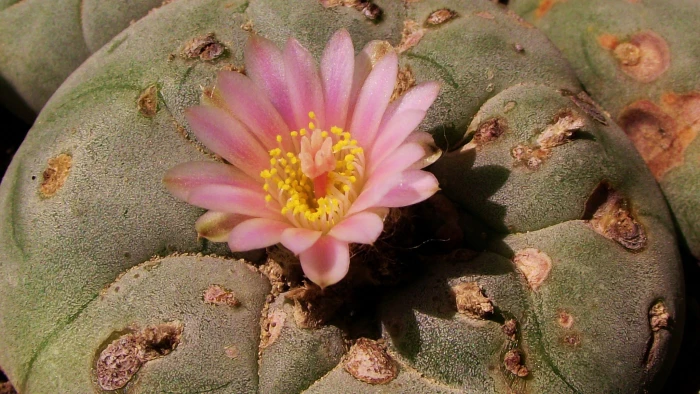Peyote
(Lophophora williamsii)
Peyote (Lophophora williamsii)
/
/

© Raúl Ernestoo
CC BY-SA 4.0
Image By:
© Raúl Ernestoo
Recorded By:
Copyright:
CC BY-SA 4.0
Copyright Notice:
Photo by: © Raúl Ernestoo | License Type: CC BY-SA 4.0 | License URL: http://creativecommons.org/licenses/by-sa/4.0/ | Uploader: raulernestoo3 | Publisher: iNaturalist |
















































Estimated Native Range
Climate Requirements for Pottstown, Pennsylvania
| This Plant | Your Site | Plant Suitability for Your Location | ||
|---|---|---|---|---|
| • Precipitation | 13" - 16" | 44" | Aquatic | Aquatic |
| • High Temp. | 84°F - 95°F | 86°F | Your summer temperatures are normal for this plant. | Excellent |
| • Low Temp. | 36°F - 44°F | 21°F | Your winter temperatures may be too cold for this plant | Too cold |
This plant may not grow well at your location - your precipitation is too high.
Summary
Lophophora williamsii, commonly known as Peyote, is a small, spineless cactus native to the Chihuahuan Desert and areas of the Rio Grande Valley in Texas, as well as the states of Coahuila, Nuevo León, and Tamaulipas in Mexico. It is typically found in arid and semi-arid habitats, often growing in limestone soils among shrubs and small trees. This cactus is slow-growing, reaching a height of 2-7 centimeters and a diameter of 4-12 centimeters. Its appearance is characterized by flattened, blue-green to yellow-green globular shoots with tufted areoles and no spines. Peyote is renowned for its beautiful pink or white flowers that bloom in spring, and the flowers are followed by small, edible pink fruits.
Peyote is valued for its historical and cultural significance, particularly for its psychoactive alkaloids, such as mescaline, which have been used in traditional Native American spiritual practices for thousands of years. While not commonly cultivated for ornamental purposes due to legal restrictions, it is of interest to cactus enthusiasts and researchers. Peyote requires well-draining soil, minimal water, and full sun to partial shade. It is susceptible to fungal diseases if overwatered or kept in humid conditions. Due to its slow growth and overharvesting in the wild, Peyote is considered vulnerable and is protected under CITES. Cultivation should be done responsibly and legally, with an understanding of its cultural significance and ecological role.CC BY-SA 4.0
Peyote is valued for its historical and cultural significance, particularly for its psychoactive alkaloids, such as mescaline, which have been used in traditional Native American spiritual practices for thousands of years. While not commonly cultivated for ornamental purposes due to legal restrictions, it is of interest to cactus enthusiasts and researchers. Peyote requires well-draining soil, minimal water, and full sun to partial shade. It is susceptible to fungal diseases if overwatered or kept in humid conditions. Due to its slow growth and overharvesting in the wild, Peyote is considered vulnerable and is protected under CITES. Cultivation should be done responsibly and legally, with an understanding of its cultural significance and ecological role.CC BY-SA 4.0
Plant Description
- Plant Type: Succulent
- Height: 0.1-0.25 feet
- Width: 1.5-5 feet
- Growth Rate: Slow
- Flower Color: Pink, White
- Flowering Season: Spring, Summer, Fall
- Leaf Retention: Evergreen
Growth Requirements
- Sun: Full Sun, Part Shade
- Water: Low
- Drainage: Fast
Common Uses
Low Maintenance, Potted Plant
Natural Habitat
Chihuahuan Desert and areas of the Rio Grande Valley in Texas, as well as the states of Coahuila, Nuevo León, and Tamaulipas in Mexico
Other Names
Common Names: Peyote, Divine Cactus, Peyotl, Cactus Pudding, Devil’s-Root, Diabolic-Root, Mescal Button, Dry-Whiskey
Scientific Names: Lophophora williamsii, Anhalonium lewinii, Anhalonium williamsii, Anhalonium williamsii, Ariocarpus williamsii, Echinocactus lewinii, Echinocactus lewinii, Echinocactus lewisii, Echinocactus williamsianus
GBIF Accepted Name: Lophophora williamsii